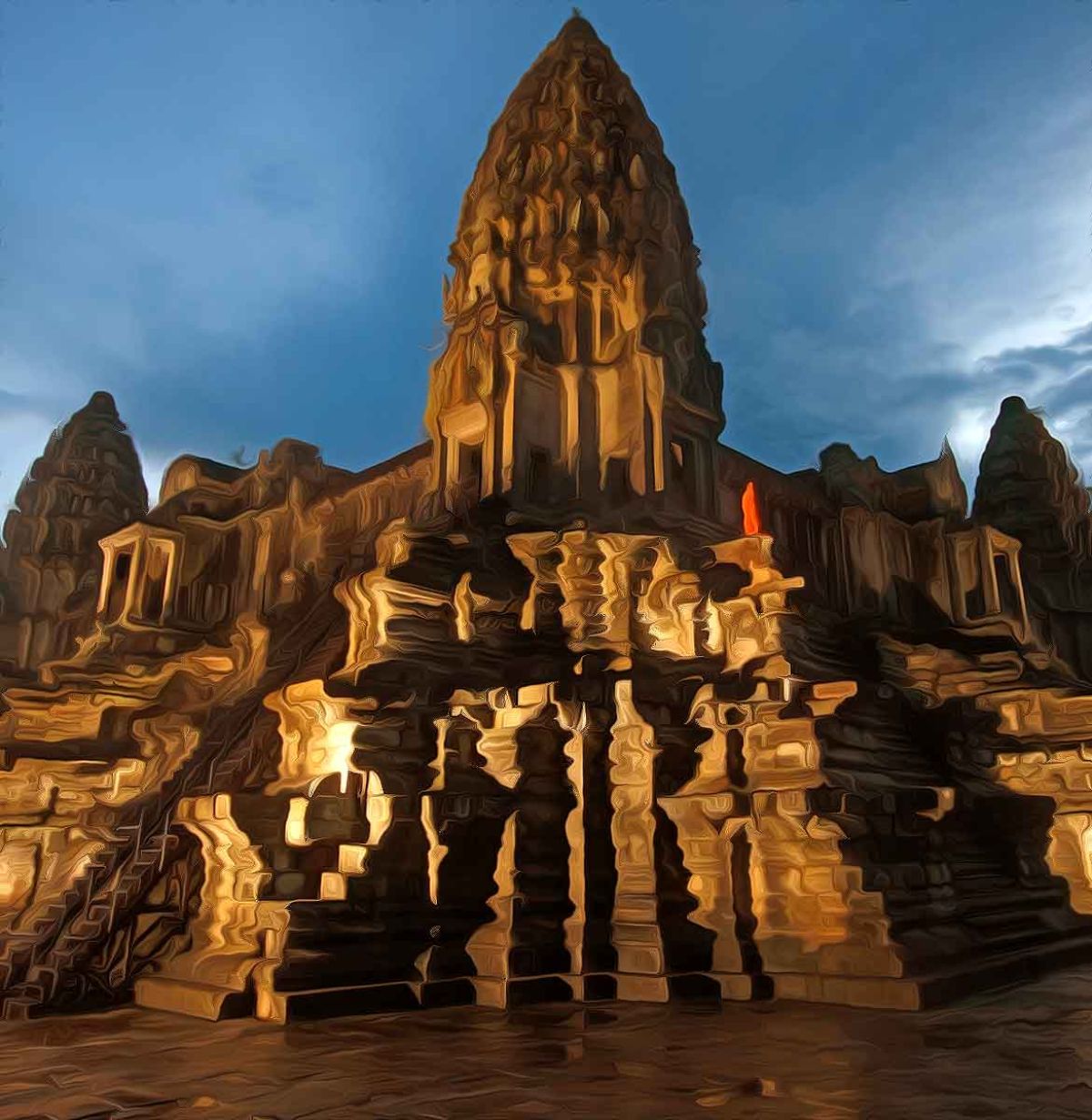More Coverage
Twitter Coverage
Satyaagrah
Written on
Satyaagrah
Written on
Satyaagrah
Written on
Satyaagrah
Written on
Satyaagrah
Written on
Join Satyaagrah Social Media
"Whenever Sanatan restores something, it restores it to a place greater than it was before": India restoring-renovating Angkor Wat temple complex in Cambodia because our civilization is not limited to India but is spread across countries ~ MEA Jaishankar

The Angkor Wat temple complex in Cambodia is being restored by India because our civilization is not limited to India, but is spread across countries, External Affairs Minister S Jaishankar on Sunday said.
|
Addressing the Kashi Tamil Sangamam on the subject 'contribution of temples in society and nation building' being held here, Jaishankar said, "There are temples not only in India, not only in the Indian subcontinent but in many regions beyond."
"I had gone with the Vice President to see the biggest temple in the world -- the Angkor Wat temple complex. Today, we are restoring and renovating the temples in Angkor Wat. These are contributions which we are making outside because the civilization of India has gone beyond India," he said.
"So, today when we are restoring, rebuilding, and re-energizing Indian civilization, our task is not only in India. Our task is all over the world. But, it is not only where our civilization went, but it is also where our travelers went, our traders also went, our people of faith went," he said.
Recalling his days as India's ambassador to China, the minister said, "Some of you know that for many years, I have been an ambassador to China. I have seen the remnants of Hindu temples even in China on the east coast."
He said that there is a very special connection between Ayodhya and Korea, whose people want to be associated with the developments in Ayodhya, he said.
He also mentioned that Shrinath jee temple in Bahrain, and said, "All these were established by our people when they went out. It is a matter of pride for us that we are building a temple in UAE, and we got approval to build a temple in Bahrain. We have done a lot of work in Vietnam."
"So, how do we today take our culture out, take our values, our philosophy, our way of life, and share it with the rest of the world through activities outside? We are very committed in the foreign ministry to do that. We also support what the people of India are doing outside. There are more than 1,000 temples in the US," he said.
He said that there are 3.5 crore Indians and people of Indian origin abroad, who have taken Indian culture with them abroad. "So, it is also our efforts today to support them, and we do it in different ways."
Jaishankar also informed the audience that Prime Minister Narendra Modi has pledged Rs 200 crore to build a Ramayan Circuit into Nepal, "so that all of us will have an opportunity to visit our heritage in close quarters."
"Even in Sri Lanka, we restored the Thiruketheeswaram Temple in Mannar. This temple was closed for 12 years. So the fact that we took interest, made efforts, has made it possible for the revival of that temple," he said.
Thiruketheeswaram Temple, one of the five sacred Ishwarams dedicated to Lord Shiva, is venerated by Shaivites throughout the subcontinent and the temple was testimony to the most difficult period in the history of Sri Lanka as it was closed for 12 years during the armed conflict and reopened in 2002.
The minister also said that in Nepal after the 2015 earthquake, many temples were damaged because they were old. "We have committed USD 50 million for the restoration of cultural heritage in Nepal."
|
Angkor Wat: everything you need to know about Cambodia's most iconic temple
The majestic temples of Angkor in northwest Cambodia are a Unesco World Heritage site and top of the historic hit list for many travelers to Southeast Asia.
The ultimate statement of Khmer architectural ingenuity, the one and only Angkor Wat is the largest religious building in the world and the perfect blend of symbolism and symmetry. Almost every inch of this immense complex is covered with intricate carvings and motifs, so it pays to do a little homework on this most iconic of temples and start planning your bucket list adventure to the temples of Angkor.
What is Angkor Wat?
Angkor Wat – built by Suryavarman II (r 1113–50) – is the earthly representation of Mount Meru, the Mount Olympus of the Hindu faith, and the abode of ancient gods. The Cambodian god-kings of old each strove to better their ancestors’ structures in size, scale, and symmetry, culminating in what is believed to be the world’s largest religious building.
The temple is the heart and soul of Cambodia and a source of fierce national pride. Unlike the other Angkor monuments, it was never abandoned to the elements and has been in virtually continuous use since it was built.
|
Special features of Angkor Wat
Western orientation
Symbolically, the west is the direction of death, which once led a large number of scholars to conclude that Angkor Wat must have existed primarily as a tomb. This idea was supported by the fact that the magnificent bas-reliefs of the temple were designed to be viewed in an anticlockwise direction, a practice that has precedents in ancient Hindu funerary rites. Vishnu, however, is also frequently associated with the west, and it is now commonly accepted that Angkor Wat most likely served both as a temple and as a mausoleum for Suryavarman II.
While Suryavarman II may have planned Angkor Wat as his funerary temple or mausoleum, he was never buried there as he died in battle during a failed expedition to subdue the Dai Viet (Vietnamese).
Celestial nymphs
Angkor Wat is famous for having more than 3000 beguiling apsaras (heavenly nymphs) carved into its walls. Each of them is unique, and there are 37 different hairstyles for budding stylists to check out. Many of these exquisite apsaras were damaged during efforts to clean the temples with chemicals during the 1980s, but they are being restored by the teams with the German Apsara Conservation Project. Bat urine and droppings also degrade the restored carvings over time.
The bas-reliefs
Visitors to Angkor Wat are struck by its imposing grandeur and, at close quarters, its fascinating decorative flourishes. Stretching around the outside of the central temple complex is an 800m-long (2624ft) series of intricate and astonishing bas-reliefs – carvings depicting historical events and stories from mythology.
|
What does it mean?
Eleanor Mannikka explains in her book Angkor Wat: Time, Space and Kingship that the spatial dimensions of Angkor Wat parallel the lengths of the four ages (Yuga) of classical Hindu thought. Thus the visitor to Angkor Wat who walks the causeway to the main entrance and through the courtyards to the final main tower, which once contained a statue of Vishnu, is metaphorically traveling back to the first age of the creation of the universe.
Like the other temple-mountains of Angkor, Angkor Wat also replicates the spatial universe in miniature. The central tower is Mount Meru, with its surrounding smaller peaks, bounded in turn by continents (the lower courtyards) and the oceans (the moat). The seven-headed naga (mythical serpent) becomes a symbolic rainbow bridge for humankind to reach the abode of the gods.
How was Angkor Wat built?
The sandstone blocks from which Angkor Wat was built were quarried from the holy mountain of Phnom Kulen, more than 50km (31mi) away, and floated down the Siem Reap River on rafts. The logistics of such an operation are mind-blowing, consuming the labor of thousands. According to inscriptions, the construction of Angkor Wat involved 300,000 workers and 6000 elephants. It was not fully completed.
Getting orientated at Angkor Wat
Moat
Angkor Wat is surrounded by a 190m-wide moat, which forms a giant rectangle measuring 1.5km by 1.3km. From the west, a sandstone causeway crosses the moat.
Outer wall
The rectangular outer wall, which measures 1025m by 800m (3363ft by 2625ft), has a gate on each side, but the main entrance, a 235m-wide (82ft) porch richly decorated with carvings and sculptures, is on the western side. There is a statue of Vishnu, 3.25m (1066ft) in height and hewn from a single block of sandstone, located in the right-hand tower. Vishnu’s eight arms hold a mace, a spear, a disc, a conch and other items. You may also see locks of hair lying about. These are offerings both from young people preparing to get married and from pilgrims giving thanks for their good fortune.
Avenue
The avenue is 475m long (1558ft) and 9.5m wide (31ft) and lined with naga balustrades, leading from the main entrance to the central temple, passing between two graceful libraries and then two pools, the northern one a popular spot from which to watch the sunrise.
Central complex
The central temple complex consists of three stories, each made of laterite, which enclose a square surrounded by intricately interlinked galleries. The Gallery of a Thousand Buddhas (Preah Poan) used to house hundreds of Buddha images before the war, but many of these were removed or stolen, leaving just the handful we see today.
Towers
The corners of the second and third stories are marked by towers, each topped with symbolic lotus-bud towers. Rising 31m (102ft) above the third level and 55m (180ft) above the ground is the central tower, which gives the whole grand ensemble its sublime unity.
Upper level
The stairs to the upper level are immensely steep because reaching the kingdom of the gods was no easy task. Also known as Bakan Sanctuary, the upper level of Angkor Wat is open to a limited number per day with a queuing system.
Temple etiquette
As the temples of Angkor represent a sacred religious site to the Khmer people, visitors are asked to dress modestly. It is not possible to visit the highest level of Angkor Wat without upper arms covered and shorts to the knees. Local authorities have visitor “code of conduct” guidelines and a video to encourage appropriate dress, as well as reminding tourists not to touch, sit or climb on the ancient structures, to pay attention to restricted areas, and to be respectful of monks.
Planning your trip to Angkor Wat
- Best time to go: it is possible to visit Angkor Wat at any time of year, but peak season is from November to February, when the weather is dry and cooler, although it’s still hot for most. The best time of day is sunrise when it’s cooler but crowded, or lunchtime when most of the tour groups are in town. It is also popular at sunset when the temple can develop a soft glow in the warm light of the late sun.
- How long you’ll need: plan at least three hours to explore the whole complex, but more like half a day if you want to explore every nook and cranny.
- Opening hours: Angkor Wat opens at 5 am for visitors who want to see the sunrise from this iconic spot. The upper level (Bakan Sanctuary) is only open from 7.30 am. Angkor Wat closes at 6 pm and is not currently open at night.
- Costs: an entry pass to the temples of Angkor costs US$37 for one day, US$62 for three days (which can be used over a period of 10 days), and US$72 for one week (which can be used over one month). However, for the remainder of 2022, tickets are on special offer. A one-day pass is valid for two days, a three-day pass is valid for five days, and a seven-day pass is valid for 10 days.
- Where to stay: Siem Reap is just 7km (4.3 mi) from Angkor Wat and is the base for exploring the temples.
- Getting around: choose from motos (motorbike taxis) for one person, remork-motos (tuk-tuks) for two, and private cars or minivans for families or small groups. Eco-friendly options include mountain bikes or electric bicycles. Guided tours can also be arranged in Siem Reap. Eco-friendly options include mountain bikes or electric bicycles and there is a new cycling path that connects the town of Siem Reap with the many temples of Angkor. Guided tours can also be arranged through hotels and tour operators in Siem Reap.
PTI
 Support Us
Support Us
Satyagraha was born from the heart of our land, with an undying aim to unveil the true essence of Bharat. It seeks to illuminate the hidden tales of our valiant freedom fighters and the rich chronicles that haven't yet sung their complete melody in the mainstream.
While platforms like NDTV and 'The Wire' effortlessly garner funds under the banner of safeguarding democracy, we at Satyagraha walk a different path. Our strength and resonance come from you. In this journey to weave a stronger Bharat, every little contribution amplifies our voice. Let's come together, contribute as you can, and champion the true spirit of our nation.
 |  |  |
| ICICI Bank of Satyaagrah | Razorpay Bank of Satyaagrah | PayPal Bank of Satyaagrah - For International Payments |
If all above doesn't work, then try the LINK below:
Please share the article on other platforms
DISCLAIMER: The author is solely responsible for the views expressed in this article. The author carries the responsibility for citing and/or licensing of images utilized within the text. The website also frequently uses non-commercial images for representational purposes only in line with the article. We are not responsible for the authenticity of such images. If some images have a copyright issue, we request the person/entity to contact us at This email address is being protected from spambots. You need JavaScript enabled to view it. and we will take the necessary actions to resolve the issue.
Related Articles
- "Miracles are not contrary to nature, but only contrary to what we know about nature": Behold the sacred marvel nestled within the heart of Shillong, Meghalaya—the Swayambho Shiv Ling in Mawjymbuin Caves drawing devotees from all corners of the country
- “Sacred space is where you can find yourself over and over again”: Goa govt inked a MOU with Temple Connect to position Goa, popularly known as 'Bhagwan Parshuram Bhoomi', to be a global destination for spiritual tourism as 'Dakshin Kashi' of India
- Tipu Sultan remembered as killer of Brahmins and demolisher of temples in many villages of Tamil Nadu: a freedom fighter or Islamic bigot?
- NMA received outrage from Netizens for asking ASI to remove Ganesh idols from Qutub Minar complex to National Museum as it will remove the big evidence of Islamist vandalism: Ganesha is the prime god of Hinduism
- "There is no knife that cuts so sharply and with such poisoned blade as treachery": Vishnu temple of Malai Mandala Perumal in Tamil Nadu has been encroached by Muslims who have turned the place into an Islamic place of worship because of neglect of HRCE
- "Every experience is an opportunity to encounter the Divine": Manikaran Shiva Temple, Parvati Ghati, Himachal Pradesh, India where you can witness hot water springs and the temperature varies from 45° to 60° that is used for boiling rice as a Prasadam
- Proud Kalyan Singh refused to give orders to shoot Karsevaks and chose to resign as CM of UP instead: Karsevaks not only reached atop the dome but had also started breaking it, where Ram Mandir stands today
- “I am Shakti, as well as Shiva. I am everything male and female, light and dark, flesh and spirit": History of Shivalinga at Tongaji Temple, Nagoya, Japan, a Buddhist temple of the Sōtō Zen sect located in Nagoya, originally built in 1532 by Oda Nobuyuki
- Ashok Gehlot-Led Congress Govt in Rajasthan unleashed bulldozer to demolish 300-year-old Hindu temple in Alwar, houses of 85 Hindu families to ‘widen road’ citing masterplan: Over hundred families homeless in Rajgarh
- Does the Places of Worship Act 1991, really forbids any transformation in worship’s religious character after August 15, 1947? Gyanvapi compound may lead to its exemption if found more than 100 years old
- "Abandoned homes become magnets for vandalism and crime": Tamil Nadu HRCE Board, trusted with the protection of temples is vandalizing temple sculptures in name of modern construction, greed for Civil Contracts resulted in shocking renovation works
- Muslim fundamentalists are not afraid of the Supreme Court of Pakistan and the government, demolished famous Hinglaj Mata Mandir in Pakistan: 11th attack in 22 months by religious fanatics
- Renowned Archaeologist KK Mohammed confirms, '27 temples were demolished to build Quwwat-ul-Islam Mosque near Qutub Minar in Delhi, hiding truth is a mistake': Remnants of temples, Lord Ganesha temple found
- Why Hindus not claiming their temples back from the Government control: Is pro-Hindu govt will always be in power
- “The bigmouths never visited Lord Ram’s birthplace and kept on playing politics”: Ram Mandir chief priest says only BJP cares about Ram Mandir, Modi did Shilanyas and CM Yogi visited 40 times
























